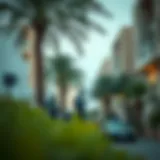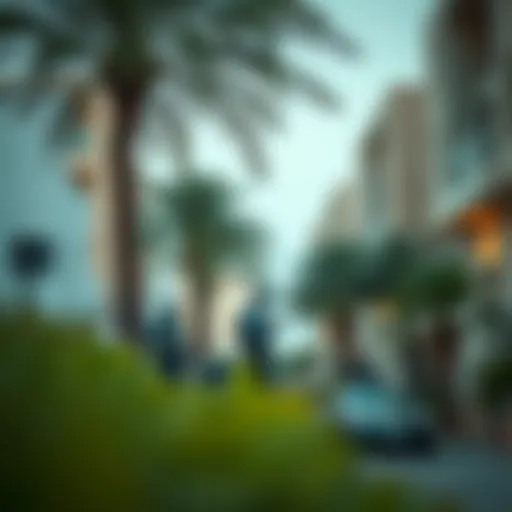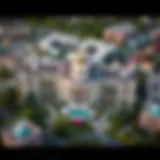Exploring Al Khail: Dubai's Vital Transportation Corridor
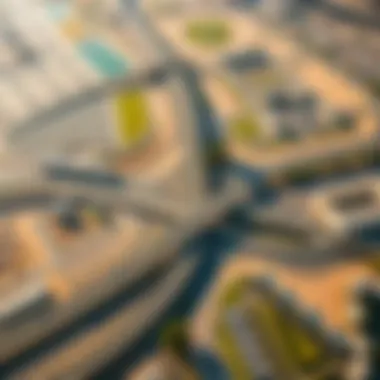

Intro
Al Khail stands as more than just a roadway; it represents a vital pulse in Dubai's ever-evolving landscape. Stretching across the emirate, this corridor plays a key role in facilitating transportation, housing, and economic activities. With roots intertwined in the historical development of the city, Al Khail has transformed into a catalyst for growth, inviting both local and international investments. This article seeks to peel back the layers of Al Khail, examining its historical significance, current market dynamics, and future opportunities available for homebuyers, investors, real estate agents, and developers alike.
With rapid urbanization in Dubai, it becomes critical to grasp the intricacies of Al Khail. Understanding its influence on real estate and infrastructure can provide insights that are invaluable for those engaged in the property market. But we won’t stop at simply analyzing the route; we’ll delve into the repercussions of demographic shifts, economic factors, and future projections that mold this eponymous corridor.
As we venture through the sections, expect a detailed analysis—one that not only highlights the current landscape but also lays out the trends and opportunities that could define the next chapter for Al Khail. Whether you're a seasoned investor or a curious observer, the insights shared here aim to guide your decisions in this multifaceted environment.
Market Trends and Analysis
Current Market Overview
The Al Khail corridor has seen significant uptick in both commercial and residential real estate activity. With the city continually expanding, areas along this route have become hotspots for development. The demand for residential units is fueled by an increasing influx of expatriates and professionals looking to settle in Dubai, attracted by its cosmopolitan lifestyle and unparalleled amenities. Properties in neighborhoods adjoining Al Khail are not just homes; they are opportunities tinged with promise.
While major developers like Emaar Properties and Nakheel have carved their niches, other significant players have entered the fray, responding to the high demand. New projects are popping up that cultivate a blend of luxurious living and accessibility to economic hubs. For instance, the development of communities such as Dubai Hills Estate showcases modern architecture that balances nature and urban life, enhancing the overall appeal along Al Khail Road.
Future Projections
Looking ahead, projections indicate that the demand for real estate along Al Khail will not just continue but might indeed soar. Anticipated infrastructural developments such as the completion of new metro links and highways will enhance connectivity, pulling more people and businesses towards this corridor. As urban planners target smart city initiatives, Al Khail stands to benefit tremendously, merging lifestyle with technological advancements.
Historical Context of Al Khail
Delving into the historical context of Al Khail provides a crucial understanding of its significance in Dubai's urban development. This analysis not only showcases the roadway's past but also highlights the interplay between architectural evolution and societal needs, which has shaped its development over the decades. The historical backdrop creates a solid foundation for understanding how Al Khail has transformed into a prominent corridor within the emirate.
Origin and Development
The origins of Al Khail can be traced back to the early days of Dubai's development, when the emirate was a small fishing village. In those days, streets were often unpaved and communication limited. As Dubai began to thrive economically, especially after the oil boom in the late 20th century, the need for a robust infrastructure became pressing.
Construction of Al Khail started in the early 2000s as part of larger plans to enhance connectivity across the city. Named after the Arabic word for 'the saddle,' this roadway was envisioned not only as a functional transport route but as a connector of communities. With its completion, Dubai's streets became less congested, facilitating smoother commutes and driving urban expansion.
Before long, businesses recognized the value of being close to Al Khail, leading to the development of commercial areas nearby. This shift was not only about roads and buildings; it encapsulated the evolving lifestyle of residents who began to seek convenience and accessibility in their everyday lives. A growing number of people found themselves drawn to locations near Al Khail due to the connectivity it provided to key districts.
Transformation through Urbanization
As the years rolled by, urbanization took the reins of Al Khail’s development. This roadway has become a pivotal element in the expansion narrative of Dubai, reflecting larger trends in population growth and economic diversification. With the city sprawled out around this corridor, vast project announcements and developments materialized along its edges, turning it into a bustling hub.
The transformation didn’t come without challenges. Managing the rapid urban growth posed questions about sustainability and environmental conservation. As new residential and commercial projects arose, authorities had to walk a fine line balancing development needs with ecological considerations. For instance, the inclusion of parks and recreational spaces along Al Khail is a fundamental response to rising demands for green urban environments.
Furthermore, Al Khail has allowed for demographic shifts, showcasing the diversity of the populace as various communities have settled in close proximity. This blend of cultures plays a significant role in community dynamics, knitting a rich tapestry of experiences and lifestyles. One can observe a distinct vibrancy here, stemming from the mosaic of backgrounds contributing to the overall ambiance.
"Al Khail is not just a road; it’s a pathway of progress that mirrors Dubai’s remarkable journey."
For more on the historical overview of Dubai’s infrastructure, visit Britannica and explore further insights.
Geographical Significance
Understanding the geographical significance of Al Khail is key to grasping its role in the urban fabric of Dubai. Its location acts as a backbone for the city's transportation network, connecting various parts of the emirate in a seamless manner. Al Khail is strategically important due to its ability to bridge essential locations and facilitate the movement of people and goods. This contributes not only to local convenience but also to broader economic engagement, making the corridor a linchpin in the expanding landscape of Dubai.
Strategic Location within Dubai
Al Khail Road stretches across the heart of Dubai, linking vital neighborhoods and commercial sectors alike. Its route is designed to provide direct access to both bustling urban centers and the quieter suburban areas, making it a critical thoroughfare for both residents and visitors.
- Connectivity: Al Khail seamlessly connects areas such as Downtown Dubai, the Dubai Marina, and Dubai Silicon Oasis, which are all significant points for residential, commercial, and technological activities. This interconnectedness enables efficient transport for commuters as well as delivery of supplies for local businesses.
- Access to Major Highways: The road intersects with several major highways, including Sheikh Zayed Road and Emirates Road, which are vital for both local traffic and external travel needs. This access not only eases vehicular movement but also enhances trade routes across the UAE.
- Urban Expansion: As Dubai continues to stretch towards its borders, Al Khail serves as a catalyst in contextualizing development practices within new districts. Neighborhoods springing up along this corridor benefit from its strategic placement, attracting both homebuyers and investors keen on capitalizing on the area's growth potential.
Proximity to Key Landmarks
The proximity of Al Khail to several landmark destinations underscores its significance in Dubai's urban showcase.
- Cultural and Recreational Venues: Key attractions such as The Dubai Mall, Burj Khalifa, and Dubai Opera are just a short drive away. This high accessibility enriches the experience for both residents and tourists alike, often driving foot traffic and promoting local businesses along the corridor.
- Educational Institutions: Renowned schools and institutions are also within close reach, making it an appealing area for families. This adds value to the residential properties along Al Khail, as parents prioritize accessibility to quality education for their children.
- Healthcare Facilities: The corridor is not far from top-tier hospitals and medical centers, offering peace of mind for residents regarding healthcare access.
In summary, the geographical significance of Al Khail extends beyond mere placement on a map. Its strategic location and proximity to essential landmarks foster an environment ripe for opportunity, making it an attractive prospect for various stakeholders in Dubai's real estate market. From the bustling energy of commercial districts to the tranquility of residential zones, the corridor encapsulates the diverse opportunities that define Dubai’s development journey.
Infrastructure and Connectivity
The role of infrastructure and connectivity along Al Khail is instrumental in shaping the overall landscape of Dubai. This critical corridor not only facilitates the seamless movement of people and goods but also acts as a catalyst for economic growth and urban development. A robust infrastructure system underpins various facets of life here, creating opportunities for homebuyers, investors, real estate agents, and developers. The efficient connectivity provided by Al Khail is pivotal for business engagement, daily commuting, and recreational activities.
Road Network Overview
Al Khail Road is an arterial highway that connects several key areas in Dubai, functioning as a vital conduit for traffic. Stretching approximately 32 kilometers, it serves multiple important districts, including Sports City, Dubai Hills Estate, and the expansive area of Dubai Marina.
The well-planned road network incorporated multiple lanes, onramps, and off-ramps which drastically reduce travel times and congestion levels. It is essential to note that the road transforms daily commute into a smooth experience and is particularly advantageous during peak hours, when many professionals are traveling to business hubs. The integration of intelligent traffic management systems ensures that traffic flow remains optimal, lessening the risk of bottlenecks.
Traffic statistics reveal that Al Khail handles a substantial volume of vehicles daily—essential for supporting a growing population and commercial activities. In addition, ongoing maintenance and upgrades ensure that the road remains in prime condition, allowing for enhanced safety and increased efficiency over the long term.
Al Khail’s strategic placement leads to its interconnectivity with other major roads such as Sheikh Mohammed bin Zayed Road and Sheikh Zayed Road, which further improves accessibility to different parts of Dubai and the surrounding emirates.
Public Transportation Options
In addition to a well-connected road infrastructure, Al Khail is bolstered by various public transportation options that cater to a diverse array of commuters. The UAE's commitment to developing public transit systems significantly benefits the residents and workers in the Al Khail area, providing an alternative to private vehicle use.
The Dubai Metro, with its Red Line extending toward Al Khail, offers rapid transit solutions for daily commuters. Surrounding metro stations provide easy access to Al Khail and adjacent neighborhoods, enhancing mobility for individuals without vehicles. For those preferring bus transport, the Roads and Transport Authority operates numerous bus lines that service the area, making it a viable option for people commuting to work or leisure.
Additionally, ride-sharing services and taxis are also widely available, ensuring that anyone can hail a ride at a moment's notice, further amplifying the options for residents. This multifaceted approach to public transit helps alleviate traffic congestion on Al Khail while promoting environmentally-friendly travel alternatives.
"The enhancement of public transportation options is not just a luxury; it's a necessity for sustaining a bustling urban landscape like Dubai."
Real Estate Development along Al Khail
Real estate development along Al Khail is a cornerstone for the economic landscape of Dubai. This bustling corridor acts not just as a route but as an incubator for residential, commercial, and mixed-use projects. The ever-growing demand for property in this area is driven by its strategic location, robust infrastructure, and the overall growth of Dubai's economy. As investors and homebuyers seek opportunities in a market that is continually evolving, understanding these developments becomes essential.
Residential Projects
The residential projects located along Al Khail cater to a diverse population, showcasing various styles and community living options. New neighborhoods are continually emerging, offering upscale villas, sleek apartment complexes, and affordable housing alternatives. A notable example is the luxurious developments in the Mohammed Bin Rashid City area, featuring top-notch amenities and green spaces that enhance the urban experience.
- Amenities and Facilities: Most residential projects are equipped with recreational facilities, such as swimming pools, parks, and childcare centers, which creates a family-friendly environment.
- Community Focus: Developers often emphasize creating a sense of community, with walking paths and gathering places. This focus on lifestyle not only raises property values but also attracts residents who prefer an integrated living experience.
Overall, the residential projects along Al Khail not only meet the demands of new residents who are flocking to Dubai for job opportunities but also emphasize a sustainable living environment that promotes healthy lifestyles.
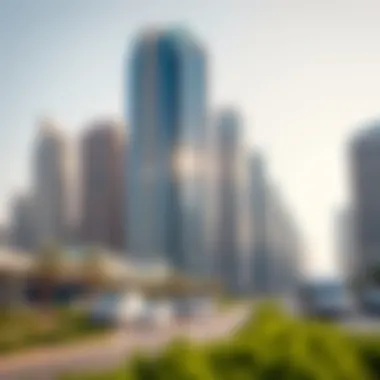

Commercial Investments
The opportunities for commercial investments along Al Khail are abundant. Major businesses and startups are drawn to the corridor due to its accessibility and visibility. Real estate buzzes with activity as new offices, retail spaces, and mixed-use developments sprout up, making it a prime location for both local and international businesses.
- Proximity to Major Hubs: Being strategically located near key transport networks enhances the appeal, allowing businesses easy access to customers.
- Diverse Offerings: From medical centers to shopping complexes, commercial investments cater to various sectors. Many investors are eyeing opportunities in e-commerce and tech development, which are gaining traction in the current market.
Leasing spaces in these commercial properties is an attractive prospect for investors, providing them with a steady stream of income and substantial long-term returns.
Mixed-Use Developments
Mixed-use developments along Al Khail exemplify the modern urban lifestyle by combining residential, commercial, and recreational components into a single space. Projects like Dubai Hills Estate illustrate how the blending of functions can lead to more vibrant communities.
- Urban Design: These developments are planned to reduce dependence on vehicles by integrating public transport options and pedestrian-friendly pathways.
- Synergy of Spaces: By housing both living and working spaces, mixed-use developments foster a sense of community, encouraging residents to engage with local businesses and services.
They not only cater to the needs of modern urban dwellers but also represent a sustainable approach to development, reducing the environmental impact of commuting and allowing for more self-sufficient neighborhoods.
Such developments offer investors a unique opportunity, given their potential for higher occupancy rates and increased demand for versatile spaces.
"Investing in real estate along Al Khail isn't just about buying property; it's about owning a piece of Dubai's vibrant future."
Market Trends in Al Khail
The market trends in Al Khail provide pivotal insights into the economic health and future potential of this vibrant corridor in Dubai. Investors, homebuyers, and real estate agents often turn their attention to these trends as they spotlight the changing landscape of urban development and investment opportunities. Whether it’s the rise in residential projects or the burgeoning commercial sector, understanding these dynamics can lead to informed decision-making.
Investment Patterns
In terms of investment patterns, Al Khail is increasingly becoming the go-to location for those looking to capitalize on Dubai's booming economy. There’s a marked uptick in both local and foreign investments, which reflects the confidence in the area's growth potential. Investors are concentrating on various property types, including luxury homes, affordable housing, and commercial real estate. Notably, about 45% of the investments cater to mid-range housing segments, illustrating a significant shift in buyer preferences.
Key factors influencing these patterns include:
- Government Initiatives: Policies promoting foreign ownership and easing regulations on property purchases for expats have positively impacted investment flow.
- Urban Development Plans: The Dubai government's vision for expansion has paved the way for new projects and has enhanced the attractiveness of Al Khail as a desirable residential and commercial area.
- Market Demand: The area’s strategic location—close to major workplaces and thoroughfares—makes it appealing for buyers seeking convenience.
To sum it up, by keeping an eye on these investment patterns, stakeholders can effectively strategize their moves, tap into lucrative opportunities, and ensure they’re not left behind in the bustling market of Al Khail.
Rental Market Analysis
The rental market in Al Khail is equally noteworthy, showcasing trends that reveal a lot about the preferences of tenants and the evolving landscape of real estate. Over the past few years, rental prices have shown resilience, managing to maintain a steady trajectory despite global economic shifts.
Several factors contribute to this positive rental climate:
- Affordable Rates: Compared to other areas in Dubai, Al Khail offers relatively affordable rental options, making it a hotspot for young professionals and families alike.
- Infrastructural Growth: The continuous enhancement of public transport and facilities in the region further elevates its appeal, attracting tenants who prioritize connectivity and ease of living.
- Diverse Tenant Base: The demographic diversity within the corridor, with expatriates forming a significant portion, drives demand for various housing types.
"The resilience of Al Khail’s rental market speaks to the area's adaptability and ongoing appeal to a diverse pool of tenants."
Demographics and Community Profiles
Understanding the demographics of Al Khail is crucial for anyone interested in the dynamics of Dubai’s development. This section sheds light on population trends and cultural diversity, both of which play a pivotal role in shaping the community and its economic landscape. Analyzing the demographic elements, especially for homebuyers, investors, real estate agents, analysts, and developers, helps in making informed decisions and strategies in this area.
Population Trends
The population trends along Al Khail tell a compelling story of growth and change. Over the past decade, there’s been a noticeable uptick in residents moving to this corridor. According to data from Dubai Statistics Center, the area attracted a mix of expatriates and locals, fostering a unique blend that reflects the vibrant character of Dubai itself.
Recent estimates suggest that the population density in neighborhoods adjacent to Al Khail has surged by around 15% annually. Factors contributing to this trend include:
- Affordable housing options: As prices in central Dubai climb, Al Khail presents more cost-effective choices for buyers and renters alike.
- Enhanced amenities: With the reinforcement of public services, like healthcare and education, the area is becoming increasingly appealing to families.
- Employment opportunities: The establishment of businesses in this corridor has drawn workers, further boosting the local populace.
As a result, developments are keeping pace with this influx, making real estate prospects more lucrative for investors. The population in this thriving area has now become a diverse tapestry, incorporating various nationalities and cultures.
Cultural Diversity
One of the most enriching facets of Al Khail is its cultural diversity. Residents hail from numerous backgrounds, creating a microcosm of global cultures that contributes significantly to the area’s social fabric. This diversity isn't just about ethnicity; it extends to lifestyle, cuisine, art, and community activities, enhancing the local experience.
Some key aspects of this cultural mosaic include:
- Culinary experiences: From traditional Middle Eastern fare to Southeast Asian delights, the food scene reflects a rich blend of global tastes.
- Community events: Festivals and cultural events are frequently organized, allowing residents to celebrate their heritage and share it with others.
- Multilingual environment: English is widely spoken, but many residents converse in their native languages, creating an inclusive atmosphere.
"A community's strength lies in its diversity; it's like a vibrant tapestry, each thread contributing a unique weave to the whole."
This cultural diversity not only enriches daily life but also enhances the area’s appeal to potential investors and homebuyers. Understanding this landscape is essential for anyone looking to navigate the Al Khail real estate market, as it offers insights into community needs and potential investment opportunities.
Economic Impact of Al Khail
The economic impact of Al Khail is not just a speck in Dubai's vast landscape; it’s more akin to a thread weaving through the fabric of this bustling emirate. It stands as a pivotal conduit that significantly influences trade, enhances local businesses, and fuels employment opportunities. Understanding this importance provides a clearer picture of how Al Khail shapes the economy and the community.
The corridor is effectively a lifeline linking various sectors, making it a prime spot for investment and growth. Not only does it foster economic activity through the movement of goods and people, but it also attracts businesses keen to capitalize on its strategic positioning. This blend of accessibility and visibility creates an ecosystem where local businesses can thrive, thereby impacting the wider economic framework of Dubai.
Local Business Ecosystem
The local business ecosystem along Al Khail is ripe with potential. With numerous SMEs (small and medium enterprises) steadily popping up, the area has become a bustling hub for commerce.
Local entrepreneurs find a warm welcome here due to the competitive rental rates and proximity to clients. Whether it’s food trucks or boutique shops, the corner stores along Al Khail contribute to a vibrant street culture.
Moreover, the corridor supports various sectors:
- Retail: Showrooms and shops exhibit items ranging from high-end electronics to traditional crafts.
- Food Services: Cafés and restaurants cater to the diverse populace, offering flavors from around the globe.
- Professional Services: From law firms to marketing agencies, many professionals seek out opportunities along this roadway due to its accessibility.
"Al Khail serves not just as a road, but as a bridge for economic collaboration. Its impact extends far beyond mere transport."
In essence, the ecosystem along Al Khail fosters innovation, encourages networking, and drives a competitive spirit among businesses. The consistency of economic activity generates a ripple effect, ultimately boosting the local economy.
Employment Opportunities
As businesses bloom, so do job prospects. Al Khail opens up a wealth of employment opportunities within its reach.
The strong commercial presence along the corridor means that many are employing a diverse labor force. Job seekers can find roles across various sectors such as:
- Retail Positions: Sales associates, cashiers, and store managers are constantly in demand due to the numerous retail establishments.
- Hospitality Roles: With many eateries and cafes, jobs in cooking, serving, and management are plentiful.
- Office Jobs: The presence of countless businesses leads to hiring in administrative and support roles.
Notably, employment in this corridor isn’t limited to just one demographic. A mix of expatriates and locals flood the job market, enriching Dubai’s multicultural tapestry. The convenience of access makes commuting less tedious, allowing workers to efficiently reach their workplace.


While the broad avenues lined with opportunities attract talent, they also invite various training programs and workshops to equip the workforce with essential skills, improving not just income but overall quality of life.
Future Prospects
The future of Al Khail is not merely a projection; it's a promising pathway that holds transformative implications for infrastructure, real estate, and overall economic growth in Dubai. As urban expansion continues, understanding the prospects for this corridor is vital for stakeholders involved in various capacities—be it investors, developers, or homeowners. The significance of this discussion stretches beyond mere speculation; it encapsulates the strategic planning that shapes the fabric of urban life in a rapidly developing metropolis.
Upcoming Infrastructure Projects
Al Khail's development isn't just a flash in the pan. Numerous infrastructure projects are slated to enhance connectivity and functionality along this vital corridor. These initiatives promise to bolster not just traffic flow, but also economic opportunities and community infrastructure.
- Expansion of Road Networks: Plans to widen sections of Al Khail Road aim to prevent congestion and facilitate smoother transit. This includes adding lanes where possible, which can ease daily commutes for residents and workers.
- Public Transport Enhancements: Dubai's Metro system is expected to extend its reach towards Al Khail, providing commuters with a reliable alternative to road travel. The infusion of tram lines or bus routes could be on the horizon, reducing reliance on personal vehicles and minimizing environmental impact.
- Smart City Features: A focus on adopting smart technologies—like intelligent traffic management systems and integrated public transport solutions—will streamline transport efficiency, making it easier for people to navigate not just Al Khail but Dubai at large.
As these projects unfold, they will likely increase demand for property along Al Khail, creating a ripple effect on local economies.
Predicted Real Estate Trends
The property market along Al Khail is poised for notable changes. Developer interest is increasingly shifting toward this corridor due to its growing significance. Several trends are shaping the future landscape of Al Khail's real estate.
- Increased Residential Development: With a surge in the population, there is a noticeable uptrend in new residential projects. Developers are banking on the area's growing popularity, leading to the construction of high-rise apartments, gated communities, and integrated lifestyle developments.
- Shift Towards Mixed-Use Spaces: There's a rising preference for mixed-use developments. These spaces combine residential, commercial, and recreational areas, allowing people to live and work within communities. Such developments cater to the needs of modern urban lifestyle, promoting convenient living.
- Sustainable Housing: As eco-awareness grows, so does the focus on sustainable living. Future projects along Al Khail are likely to incorporate green building standards and energy-efficient designs.
- Investment Opportunities: With enhanced infrastructure and connectivity, smart investors recognize the potential for lucrative gains. Both local and international investors are expected to circle the area, further driving property values upward.
The future of real estate along Al Khail is not just about bricks and mortar; it is about crafting vibrant communities that resonate with the aspirations of modern life.
In summary, Al Khail stands at the brink of rapid transformation fueled by strategic infrastructure projects and evolving real estate dynamics. Each of these facets not only paints a picture of economic viability but also enhances the quality of life for those living in and around this crucial corridor.
Challenges and Considerations
Understanding the challenges and considerations surrounding Al Khail is critical for anyone aiming to make informed decisions regarding real estate investment and community development in this vibrant corridor. These factors not only impact the local environment but also set the stage for sustainable growth and urban livability. In this section, we will explore two specific areas: environmental concerns and regulatory factors that play pivotal roles in shaping the future of Al Khail.
Environmental Concerns
Al Khail's rapid development brings along a range of environmental concerns that cannot be ignored. The expansion of infrastructure and growing population density contribute to issues like air pollution, waste management, and the depletion of natural resources. As more buildings rise, the green spaces people rely on tend to dwindle.
In the context of sustainability initiatives, developers and city planners are increasingly under pressure to meet environmental standards. Projects like green building certifications and eco-friendly urban designs are becoming more common. This shift aims not only to mitigate adverse impacts, but also to create healthier living spaces. For instance, studies have indicated that urban areas with ample green spaces tend to enjoy better air quality and foster community well-being.
"Sustainable urban planning is not just a trend; it’s a necessity for the longevity of our cities and their inhabitants."
Addressing these environmental challenges requires a collaborative effort from various stakeholders, including local government, non-profits, and the community. Comprehensive environmental assessments can guide development strategies to prioritize minimal ecological footprints while maximizing utility.
Regulatory Factors
Navigating the regulatory landscape is another key challenge associated with Al Khail. The rules and regulations governing real estate developments can be intricate and often shift in response to economic conditions and urban planning goals. Investors and developers must be diligent about staying informed on local legislation, as non-compliance could lead to costly delays and setbacks.
Some of the critical regulations include zoning laws, building codes, and permits that dictate what can be constructed and how. Additionally, certain areas may have restrictions aimed at preserving cultural heritage or protecting the environment. For prospective investors, understanding these nuances is essential. Having a solid grasp of the regulatory framework helps in identifying viable project opportunities and navigating potential obstacles without falling afoul of legal requirements.
To effectively maneuver through this complex territory, engaging with local authorities and real estate experts can be crucial. These professionals not only possess a thorough knowledge of the rules, but can also offer insights into upcoming changes that might affect investment strategies in Al Khail.
In summary, being aware of the environmental and regulatory landscapes is fundamental for anyone looking to invest or develop in the Al Khail corridor. The interplay of these factors ultimately determines the sustainability and success of projects within this notable area.
Investment Strategies for Al Khail
As the heart of Dubai continues to expand, investment strategies for Al Khail have begun to take center stage. The importance of this area in the context of the real estate market cannot be overstated. With a blend of residential, commercial, and mixed-use projects, investors have a unique opportunity to tap into a dynamic landscape that is evolving rapidly. The strategies one might adopt here have the potential to yield significant returns while also contributing to the growth of the local economy.
Investors looking at Al Khail should consider several key elements before diving in. These elements include:
- Market Demand: Understanding the demand for properties—both residential and commercial—is vital. The influx of new residents and businesses creates a fertile ground for investment.
- Infrastructure Developments: Keeping an eye on infrastructure projects in the pipeline can offer clues on future growth areas. For instance, if a new metro station is announced near Al Khail, property values in the vicinity may appreciate.
- Cultural Trends: The diverse community adds layers of opportunity, as different demographics have varying needs in housing, retail, and recreational spaces.
The benefits of strategic investments in Al Khail are manifold. Investors can not only anticipate financial gains but also play a role in shaping a community that embraces innovation and sustainability.
Identifying Key Opportunities
To effectively navigate the real estate landscape of Al Khail, it is crucial to identify key opportunities that align with market trends and demographic shifts. Key opportunities may include:
- Development of Affordable Housing: With the increasing population, there is a growing need for affordable properties without compromising on quality.
- Smart City Projects: Investors should look out for initiatives that fall under Dubai’s smart city aspirations, as these projects often receive government support and funding.
- Commercial Spaces for Small Businesses: With the rise of entrepreneurship, there is a pressing need for adaptable office spaces that cater to startups.
By pinpointing these opportunities, investors can align their strategies with what the market demands most.
Risk Management Approaches
Engaging in investment strategies comes with its share of risks. Managing these risks is as crucial as identifying opportunities. A few notable risk management approaches that investors in Al Khail should consider include:
- Market Research: Regularly conducting thorough research to keep abreast of market trends can help mitigate risks. This includes staying informed about economic indicators, interest rates, and demographic data.
- Diversification of Portfolio: By diversifying investments across different property types—residential, commercial, and mixed-use—investors can shield themselves from market volatility.
- Engage Local Experts: Consulting with local real estate agents and financial advisors who have experience within the Al Khail corridor can provide insights that might not be readily apparent from a distance.
"In real estate, knowing when to hold ’em and when to fold ’em can determine the difference between a property boom and lost opportunities."
Community Engagement and Development
Community engagement and development stand at the forefront of sustainable growth along Al Khail. This vital corridor is not just a physical route; it serves as a platform for social interaction and community building. The relationship between local residents and their environment often shapes the efficacy of urban development.
Role of Local Organizations
Local organizations play a crucial role in fostering community spirit within Al Khail. They are often the bridge between the government and residents, facilitating communication and ensuring that the voices of the community are heard. Organizations like the Dubai Community Development Authority work to promote social cohesion by initiating programs that encourage participation at various levels. These grassroots movements help in:
- Identifying community needs
- Organizing events that enhance cultural exchange
- Promoting local businesses and artisans
These collective efforts pave the way for a more inclusive atmosphere, allowing everyone to stumble upon opportunities and contribute positively.
Community involvement is not just about participation; it is about giving individuals a stake in their environment.
Public Services and Facilities
Public services and facilities in Al Khail are paramount to nurturing a high quality of life. Urban planners emphasize accessibility and convenience when it comes to services such as education, healthcare, and recreational activities.
For example:
- The establishment of local schools provides educational opportunities for families that have settled in the area.
- Healthcare facilities ensure that residents have immediate access to medical attention, crucial during emergencies.
- Green parks and community centers not only promote physical well-being but also serve as gathering spots for residents.
The integration of these services creates a ripple effect that enriches community ties and encourages collaboration among diverse groups.
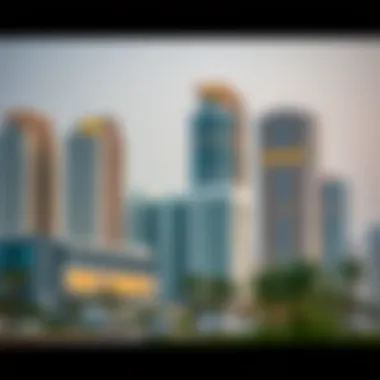

In summary, the active participation of local organizations paired with public services enhances the living experience within the Al Khail corridor, fostering a sense of belonging and making the area more attractive to homebuyers and investors alike.
Comparative Analysis with Other Dubai Corridors
Understanding the dynamics of Al Khail involves drawing comparisons with other key roadways in Dubai such as Sheikh Zayed Road and Al Ittihad Road. This exercise not only highlights Al Khail's unique characteristics but also positions it within the broader context of Dubai's urban planning and economic strategies. The comparison allows for a deeper comprehension of traffic patterns, urban development, and real estate trends, which together shape the city's growth narrative.
When looking at these corridors, one cannot overlook the distinct benefits they bring. For one, evaluating Al Khail against Sheikh Zayed Road showcases how different infrastructural designs cater to various needs. Sheikh Zayed Road has a reputation for being the heart of commerce and tourism, hosting extravagant hotels and iconic structures. In contrast, Al Khail provides a crucial link that supports residential areas and commercial zones in the new developments, standing as a modern backbone of the emirate.
Furthermore, assessing Al Khail alongside Al Ittihad Road reveals even more intricacies. Al Ittihad is known for its central role in connecting older districts to newer developments, while Al Khail is vital for ongoing expansion projects. This comparative analysis thus serves as a lens through which we can view the urban sprawl and the growth of amenities in Dubai.
"Al Khail exemplifies a contemporary approach to urban transport, designed with future expansion in mind, while the historical significance of Sheikh Zayed Road anchors the modern narrative of Dubai’s rapid evolution."
Al Khail versus Sheikh Zayed Road
When we contrast Al Khail with Sheikh Zayed Road, we encounter stark differences that speak volumes about their respective functions. Sheikh Zayed Road is often viewed as the main artery for commercial traffic, accommodating both local commuters and tourists alike. The density of skyscrapers along this road tells a story of high-value real estate, catering to businesses and luxury hotels. In this scenario, the road serves not only as a transportation route but also as an emblem of Dubai's affluence.
On the other hand, Al Khail finds its priority in facilitating residential community connectivity. The road has evolved as a conduit that links various neighborhoods to educational institutions, healthcare facilities, and retail centers. This functionality enhances living standards by reducing travel time and fostering a more interconnected community.
Factors to consider when analyzing these two corridors include:
- Traffic Patterns: Sheikh Zayed Road is notorious for congestion, especially during peak hours. Conversely, Al Khail generally experiences more structured traffic flow, boosting its appeal as a residential choice.
- Investment Potential: Real estate investors may lean towards Sheikh Zayed for high-rises and commercial ventures, while Al Khail presents opportunities for family-oriented developments, attracting a diverse demographic.
Al Khail versus Al Ittihad Road
When juxtaposed with Al Ittihad Road, Al Khail reveals its role in enhancing accessibility and fostering growth in newer developments. Al Ittihad serves a dual purpose: it provides access to some of Dubai’s historical landmarks while facilitating traffic between older and emerging urban areas. Hence, it can be perceived as a road steeped in tradition yet vital for modern linking.
Al Khail, by contrast, is synonymous with innovation and progression, designed to cope with the burgeoning demands of a growing population. Here, one can witness the differences in approaches to urban design and traffic management:
- Urban Development: Al Ittihad Road is surrounded by established neighborhoods, while Al Khail promotes urban sprawl, encouraging new residential and commercial projects.
- Community Services: Al Khail encourages localized amenities that cater to its residential demographic, whereas Al Ittihad maintains a broader appeal by incorporating cultural and historical destinations.
The Role of Technology in Al Khail Development
The evolution of Al Khail, a major thoroughfare in Dubai, can’t be discussed without modern technology's pivotal involvement. As Dubai strides toward becoming a global leader in smart city initiatives, the influence of technology ripples through various aspects of Al Khail, affecting everything from urban planning to real estate.
Smart City Initiatives
Dubai's ambitious smart city goals are transforming urban living in Al Khail. These initiatives focus on enhancing the quality of life for residents and streamlining city operations through innovative technology. The core objectives center around sustainability, efficiency, and connectivity.
Key components of smart city strategies in Al Khail include:
- Intelligent Traffic Management: Systems are being implemented to ease congestion, providing real-time data for travelers using the corridor, ensuring shorter wait times.
- Energy Management: Smart grids promote energy conservation. Buildings along Al Khail are increasingly required to meet energy efficiency standards that align with environmental guidelines.
- Public Safety Systems: Advanced surveillance and emergency response systems are integrated into the urban fabric for enhanced security, facilitating swift aid during crises.
By embedding these smart solutions, Al Khail not only upgrades its infrastructure but also positions itself as a model of modern urbanism that other cities might aspire to emulate.
Digital Infrastructure Growth
The robust growth of digital infrastructure in Al Khail serves as a backbone for the technological advancements unfolding in this corridor. With high-speed internet becoming a norm, businesses and residents alike are benefiting from enhanced connectivity.
- Data Centers and Cloud Services: The emergence of data centers in the vicinity is positioning Al Khail as a tech hub, attracting companies looking to harness cloud technology for their operations. These facilities enable businesses to store and manage their data more efficiently.
- Smart Apps and Services: Digital platforms are simplifying day-to-day activities. From residential complexes providing mobile apps for maintenance requests to commercial establishments leveraging online services to connect with customers, the ease of access enhances engagement.
- E-Government Services: The integration of governmental services into digital platforms reduces bureaucracy, allowing residents to access permits, licenses, and other civic needs swiftly through online channels.
The synergy between technological advancements and digital growth in Al Khail is setting a precedent for urban development that prioritizes both efficiency and sustainability.
Tourism Impact along Al Khail
The influence of tourism along Al Khail cannot be overstated. This thoroughfare not just provides a link between various parts of Dubai, but it significantly shapes the experience and economic landscape for visitors. As Dubai continues to market itself as a global city, increasing the stream of tourists becomes a focal point. Al Khail serves as a pivotal route that connects many tourist attractions, thus playing a crucial role in tourism impact.
Attractions and Destinations
In recent years, Al Khail has witnessed a surge in attractions, making it a must-visit for both local and international tourists. The variety is impressive, ranging from modern entertainment complexes to cultural sites. For instance,
- Dubai Motor City, which is not far from Al Khail, draws in automotive enthusiasts. Here, visitors can indulge in thrilling motorsport events and explore the latest in automotive innovations.
- Dubai Autodrome is another gem, where thrill-seekers can experience the adrenaline rush of motorsport.
- The Dubai Outlet Mall, which is directly accessible from Al Khail, has become increasingly popular among shoppers looking for good deals on high-end brands.
- Moreover, the proximity to Dubai Sports City enhances the appeal for sports fans, offering multiple venues for various events.
The location is strategic; hotels and restaurants are popping up, ensuring that when tourists come to explore these attractions, they have a plethora of options for accommodation and dining. Tourists often comment on the ease of navigating, thanks to Al Khail's wide lanes and well-maintained roadways, enhancing their overall experience.
Visitor Trends
Understanding the patterns in visitor trends sheds light on how tourism evolves along Al Khail. Recent data suggests a noticeable increase in tourism traffic during specific peak seasons, particularly around the Dubai Shopping Festival and New Year celebrations. Visitors frequently utilize Al Khail as a conduit to reach major events, contributing to the area's vibrancy.
- Statistically, seasonal spikes around 30-40% in traffic can be observed during these periods. This influx contributes to greater economic activity in local businesses and services.
- Trends indicate a growing interest in eco-friendly tourism, with some visitors keen on exploring sustainable options available along Al Khail. Many upcoming projects cater to this demographic, promoting green hotels and eco-conscious dining establishments.
According to recent surveys, tourists frequently rank convenience and accessibility as top factors in their travel decisions, further emphasizing Al Khail's importance. Additionally, the growing trend of remote work among travelers has also influenced the types of facilities being developed, attracting those who wish to combine work and leisure.
"The trajectory of tourism influenced by Al Khail demonstrates not just the growth of Dubai, but the adaptive strategies being implemented to enhance visitor experience."
In summary, the tourism impact along Al Khail not only enriches the experience for visitors but also contributes significantly to the economic framework of Dubai. As this route continues to evolve, the interplay of attractions, visitor patterns, and accessibility will likely dictate future developments and opportunities.
Sustainability Initiatives in the Al Khail Area
Sustainability has become a cornerstone principle in urban development, especially in dynamic environments like Al Khail. By adopting sustainable practices, this area not only promotes ecological balance but also enhances the quality of life for its residents and businesses. The importance of sustainability initiatives in Al Khail cannot be overstated. From energy-efficient buildings to community-driven green spaces, these initiatives are integral in shaping a resilient urban landscape.
Green Building Standards
The implementation of green building standards in Al Khail is a substantial step towards reducing the environmental impact of construction and development. These standards often involve using eco-friendly materials, reducing water consumption, and implementing advanced waste management systems. For instance, buildings designed to meet LEED (Leadership in Energy and Environmental Design) standards incorporate solar panels, energy-efficient windows, and sustainable insulation materials. Such measures not only lower utility bills for occupants but also help mitigate the urban heat island effect prevalent in cities.
These green standards are important for various stakeholders, including homebuyers and investors. Properties that adhere to these standards tend to retain higher resale values and attract eco-conscious buyers, as more and more consumers consider sustainability as a deciding factor in their purchase decisions. In addition, developers who invest in sustainable building practices can often leverage government incentives and support aimed at promoting green initiatives.
Community Green Spaces
Community green spaces, another vital aspect of sustainability in Al Khail, contribute significantly to the well-being of residents. Parks, green corridors, and recreational areas provide not only aesthetic appeal but also crucial ecological benefits, such as improving air quality and fostering biodiversity. These spaces serve as gathering points for families and friends, promoting community interaction and an enhanced sense of belonging.
Incorporating community green spaces into urban planning requires thoughtful design and community involvement. For example, Al Quoz Park, located nearby, is a prime example where native plants are utilized to minimize water usage and promote local wildlife. These spaces are so much more than just a patch of grass; they reflect the community’s values and priorities in promoting a healthy, sustainable lifestyle.
Culmination
In wrapping up our exploration of Al Khail, it becomes clear that this corridor is much more than just a route through Dubai; it stands as a pivotal zone for growth, investment, and community life. The historical layers it conceals coupled with its rapid transformation reflect the broader changes within the emirate.
Summary of Key Insights
Al Khail has emerged as a key artery, not only aiding in transportation but also in shaping economic opportunities. Here are some crucial points:
- Historical Significance: The road has evolved from its early days into a symbol of Dubai's relentless advancement.
- Real Estate Potential: A surge in developments along Al Khail speaks to its attractiveness for both investors and homebuyers.
- Community Interaction: The area's demographic shift illustrates its ability to foster a diverse community.
- Technological Integration: Ongoing smart city initiatives are enhancing accessibility and living standards.
Final Thoughts on Al Khail's Evolution
As Al Khail continues to develop, it showcases Dubai’s ability to balance growth with sustainability. The future is promising, marked by upcoming infrastructures, such as green spaces and community facilities, which are expected to promote a high quality of life. Stakeholders in real estate, from investors to developers, stand to gain immensely from the ongoing changes. Capturing the momentum of Al Khail's evolution requires a strategic vision that aligns with both local culture and global best practices. This corridor is not just where the road is paved; it’s where opportunities await, beckoning both businesses and families alike.


